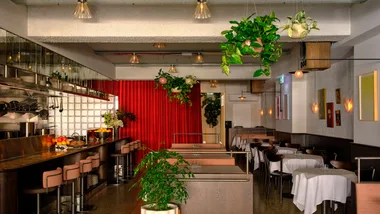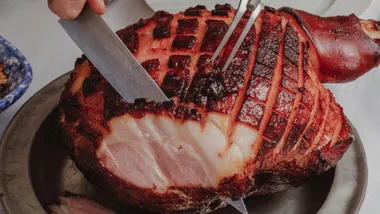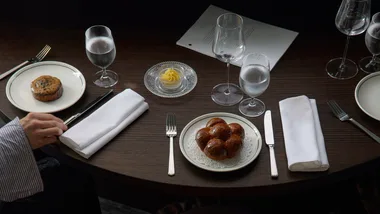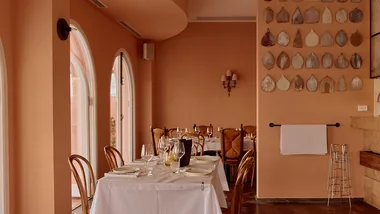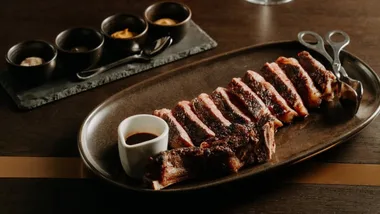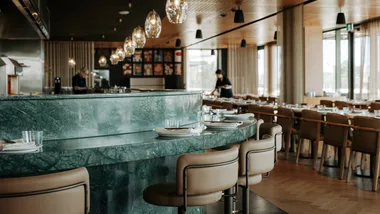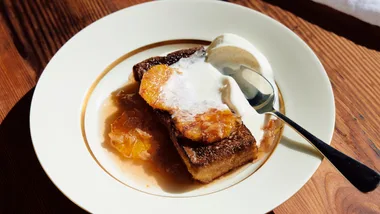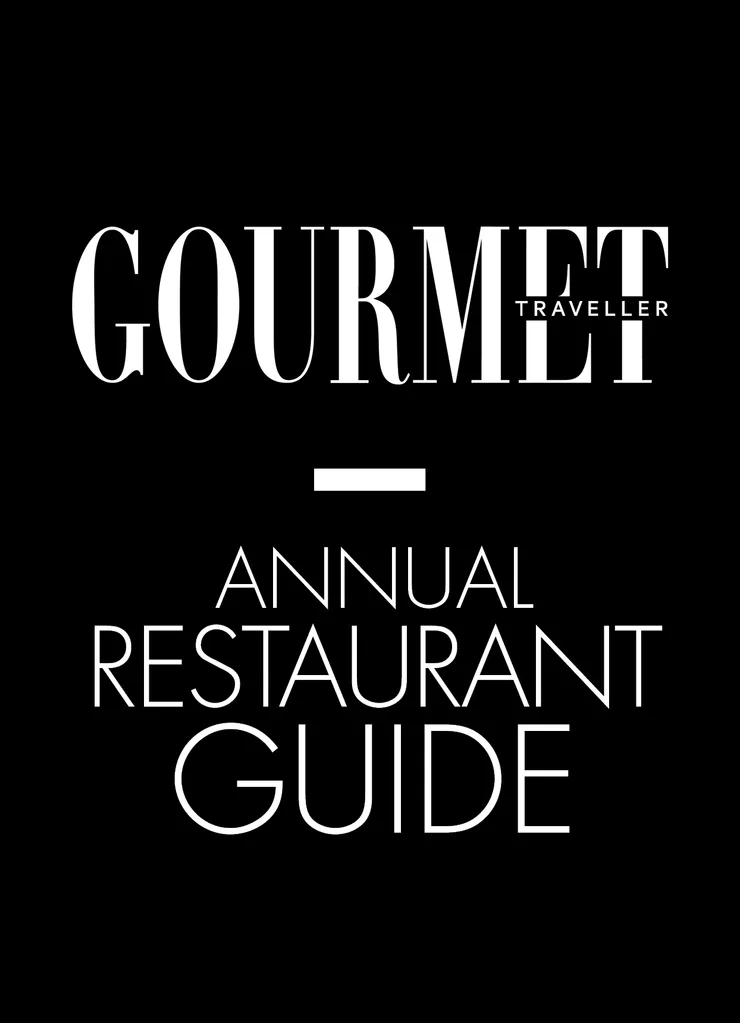What happens when an Italian chef turns to the East for inspiration? Asian-Italian dining at its knockout finest, that’s what, writes Pat Nourse.
Italians of my acquaintance are scandalised by appropriations of Italian dishes in Asian restaurants. Any mention of Japanese-style pasta or (god forbid) that modern Thai-talian classic, pad macaroni, results in shooting of eyebrow, flapping of arm and muttering about Marco Polo and the sanctity of la cucina vera. Have you ever eaten Chinese food in Italy, though? Even the lowliest cod-roe pasta-slinging goma joint or purveyor of eel fettuccine makes a more convincing argument for East meeting West than your average rosticceria Cinese and its limp toast di gamberi, gloopy maiale in salsa agrodolce and leaden gelato fritto. Unspeakable doesn’t even begin to cover it.
But what about the top end? What about when really talented Italian chefs get bitten by the chopsticks and go bamboo: could any good come of it? At LuMi, the case is being made for the affirmative.
Pretty much everything likeable about LuMi comes from the kitchen. The room is a glass box, with all the good and bad that entails, and nothing about its fittings or furniture will blow your hair back. There’s a great view of the Fairfax and Accenture buildings over the water, if you can see past the quotes inscribed in a band around the windows. (“You are confined only by the walls you create.” Whoa, deep. Which 11-year-old girl’s Instagram feed was that lifted from?)
Inside, most of the dining room is in deep shadow contrasted by the glare of the open kitchen. It’s functional – comfortable even – but there’s no question you’re here for the food because without it the place has no native buzz, no social feng shui. There’s a curious and not especially coherent or apt playlist smattered with Jack Johnson, Bon Iver and The National on the speakers, and copies of Food Service Monthly on one of the side tables. The wine list is serviceable rather than a pleasure in itself; it doesn’t stand up to the weight of the lists at Pilu or Ormeggio, say, but neither does it have the wit and sparkle of the offerings at the likes of Acme and 10 William Street. The waiters are more competent than natural; at least they’ve got charm.
But wow, when the food scores a hit, it’s Mike Tyson muscle with Cassius Clay finesse. You don’t see it coming, and it leaves you punch-drunk in the happiest of ways. It’s a tasting menu format, so there’s some pleasant enough dancing around the ropes at the beginning with a few snacks: a focaccia studded with roast potatoes that’s good enough to single-handedly rehabilitate this mighty bread beyond its retro status, a stunning little cheddar sablé biscuit, and a bowl of “Italian chawanmushi”. In Japanese restaurants, chawanmushi is a silken steamed custard concealing such treats as gingko nuts and prawns; at LuMi it’s a silken steamed custard made on a parmesan consommé base, and it’s topped with matchsticks of button mushroom and strands of enoki dressed in porcini powder. Big flavours, fine texture. The course that follows is largely goo-based, combining shreds of sand-crab, a sort-of mayo, Jerusalem artichoke, powdered oyster (less gross than it sounds) and dulse, a sea lettuce. Gooey, but full of marine savour.
Then comes one of the great surf-and-turf dishes of our age. And naught a prawn or steak in sight. The earthy qualities of LuMi’s ravioli come from the spelt base of the pasta rounds and their sweet, hot liquid butter and pumpkin purée filling. The seaside comes to the party in the form of the faintly obscene tongues of sea urchin that loll and leer on top. This is no mere stunt-casting: biting into each raviolo it all makes perfect sense, the roe a briny wave somehow riding above all that orange butteriness, with little pops of flavour in the mix from a scattering of chives and toasted pumpkin seeds. Phew, you think, mopping your brow. These buggers know what they’re doing. What else have they got up the sleeve?
Wallop! The spaghetti lands one right between the eyes. It’s a knockout. There’s layers of cleverness at work here, culminating in a dish both disciplined and muscular. It starts with the dough for the pasta being made with semolina and stinging nettles. This is cut into squared-off spaghetti on a chitarra (that stringed instrument from Abruzzo that has brought the world much more pleasure than any zither), cooked deftly, sauced, and twirled into a lime-green heap in the middle of the plate. It’s only three or four bites, but there’s so much flavour going on here, the sauce based on mussels cooked with a whole lot of aromatics (only some of them Italian) in cream, liquefied, then mixed with fennel pollen, silverbeet and crisped-up bits of guanciale. At this point it seems wise to retire to the corner of the ring while your trainer splashes water in your face and tells you to pace yourself. Hell, there’s four more rounds to go.
Perhaps it’s fortunate, then, that the eggplant and bonito number is a bit less thrilling. Jokes on the plate tend to be pretty limited in their scope. As Christopher Kostow, the chef of Californian three-star Meadowood, told a masterclass at last year’s Melbourne Food & Wine Festival, there’s only so much artistic nuance you can capture in food. “It’s not a poem; it’s a clunky medium.” Trompe-l’oeil is one of the few devices available to the chef in this arena, but, really, the old “oh hey, it’s not a piece of meat, it’s a piece of dried watermelon” routine (let alone, “oh hey, it’s not a used ashtray, it’s my dessert”) only gets you so many laughs. And so it is here with the bonito-cooked-like-it’s-eggplant-and-eggplant-cooked-like-it’s-fish. I don’t want to get all bah-humbug on you, but though the glistening sliver of marinated fish and pistachio-tinted “fillet” of melanzane are perfectly edible, and play well together with a bit of a nasu dengaku vibe, I can’t help but wonder how much tastier this one might have been if they’d made the radical move of cooking the eggplant like it’s eggplant and the fish like it’s fish. They’re talented enough that they don’t need the parlour tricks.
I don’t think it’s just my double-digit cholesterol talking when I say I’m also no huge fan of great hunks of unrendered fat. The parallel rise of pork belly and chefs developing a taste for cooking meat sealed in plastic bags has resulted in one of the least appealing trends in restaurant food in recent memory, and that’s wedges of fat barely tempered by fire. What usually happens is that the belly (or jowl or whatever) gets sealed in a bag and then cooked low and slow in a water bath to break down the connective tissue. The chef browns the meat (usually too briefly) to make up for the lost savour that you’d otherwise get cooking it in the pan, the oven or on the grill, and to further compensate for the one-dimensional texture, they’ll add crunch in the form of the skin cooked separately, say, or some fried or toasted nuts or seeds. The theory is sound, but I’d say most of the time it becomes one of those things that’s done primarily for reasons of efficiency in the kitchen rather than the diner’s pleasure.
Anyway, if you’ll pardon the editorial aside, this is not to say the piece of jowl offered as LuMi’s final savoury course isn’t okay. It’s totally okay – there’s the tender strip of pork, there’s your toasted buckwheat and crackling crumbs, a leaf of purple kale, a curl of pickled pear. Fine. But I’m not racing to eat it again. I can also take or leave the palate-cleansing course that comes after it, a blindingly verdant assembly of parsley, shiso, sorrel, lemon, mint and basil in the now-standard quenelle-crumb-gel-granita-sorbet configuration. It’s less a dessert than a breath-mint. But hey, it gets the job done.
The milk ice-cream, by contrast, is a splendid thing: its carefully titrated creaminess, the play between the smooth citrus sabayon and the sourness of the Umbrian cherries on top. More, please.
And now for the really good news: there’s a bar menu. For the not inconsiderable fraction of the populace that would rather exfoliate with a cheese grater than willingly submit themselves to an hours-long dégustation that means that all of Federico Zanellato’s culinary prowess is available to the would-be diner in a user-driven situation. Sure, there’s only a handful of seats, and the layout of the “bar” area is profoundly strange, but when the eats are this good you can let it slide. There’s hot, crisp parmesan churros (vastly superior to any sweet version sold in Sydney), a salumi-packed piadina (in no way diminished for simply being a faithful, unvarnished treatment of trad pan-fried flatbread) and pieces of lamb done “Milanese style” that are like the Platonic ideal of the milkbar crumbed-cutlet. And then there’s the tinned pasta, the sight gag of it arriving in a customised can balanced by the fact that the spaghetti inside is so well made, and sauced with as good a classic Amatriciana as anyone serves in this city. And it’s $14.
LuMi is, rather sweetly, a portmanteau of the first names of Zanellato’s twin daughters, Luna and Mia. It also means “lights” in Italian. Taking these etymologies together you could conclude that it’s a place that’s illuminating but has plenty of heart. It’s a refreshing and entirely welcome combination, bringing together sincerity and ambition in just the right proportions.
If this is the new face of Italo-Asian dining, hand us the spaghetti chopsticks – you can count us in.


